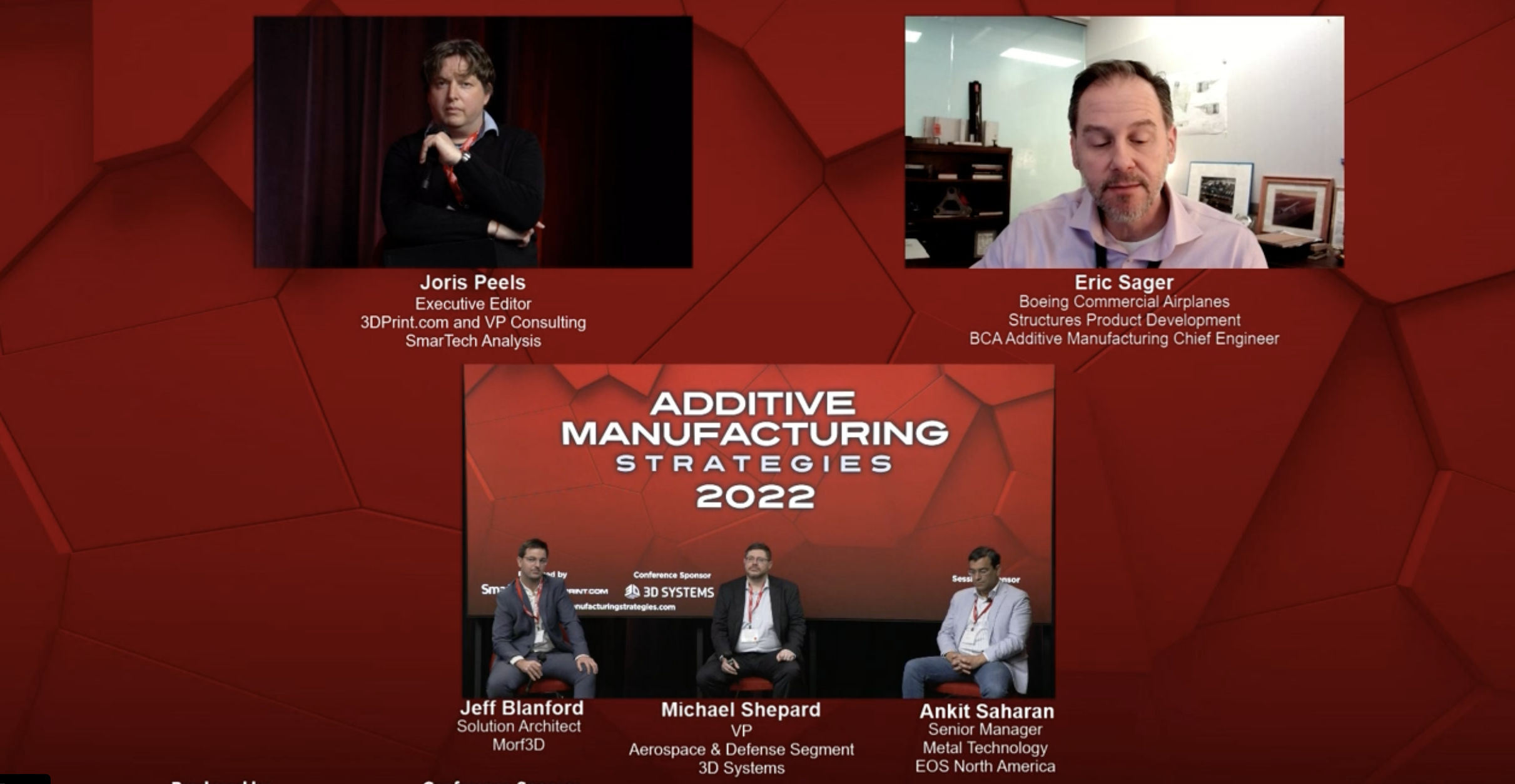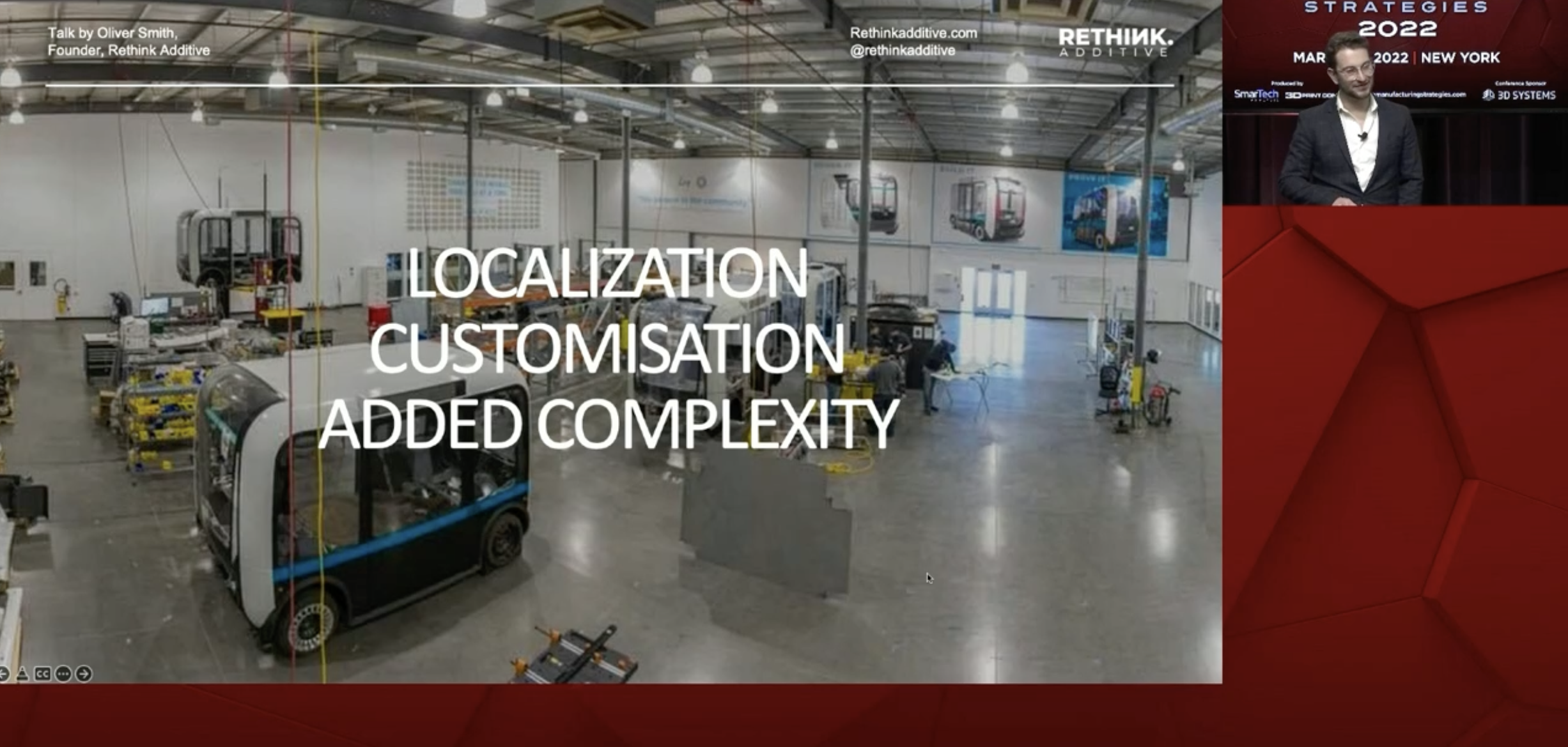The last day of Additive Manufacturing Strategies (AMS) was packed full of panels and lively discussions about the mobility sector, more specifically aerospace and automotive. From new trends to engineering advances, experts focused on creating lightweight parts, mass customizations, qualifications, and certifications.
Aviation and Space 3D Printing
To start the discussion on AM in aviation and space, 3DPrint.com Executive Editor Joris Peels led a panel of experts who highlighted the importance of creating lightweight parts. First up, Morf3D Solution Architect Jeff Blanford said aerospace is where lightweight is probably most important and where engineers are taking advantage of AM capabilities because the industry pays the highest penalty for weight.
“Every time we make any decision, weight is the ultimate premium,” highlighted Blanford.
This talk focused on looking at optimizing AM techniques to create lightweight parts, and, as the senior manager at EOS, Ankit Saharan was able to offer his own unique perspective on one of the main challenges of the AM experience with aerospace: “I would say that 90 to 95% of applications that we see today are always legacy applications.” It seems that while there is a legacy part footprint that people are looking to redesign, only 5% of applications are starting from scratch.
Blanford agreed and added that the issue is that many companies still have to work with legacy parts, finding a way to replace parts designed for casting, forging, or milling (among other traditional manufacturing methods) instead of starting anew.
Like his co-panelists, Boeing’s AM Chief Engineer Eric Sager said the value proposition of part replacement with AM is smaller than starting from a new product perspective. Even though the time horizon is long for these new parts, “that thread of continuity as this industry matures is a big challenge and something we are focusing on.”
But aerospace is risk-averse, evoked 3D Systems’ Aerospace and Defense Segment VP Michael Shepard, who reminded the audience that historically, companies in the industry have gravitated towards known, fixed validated processes that are reliable and produce the same result again and again.
“For AM, there is a tremendous ability to add value, but the aerospace world is going to have to come to grips with techniques that will allow them to have more agility than what served well with forging, castings, and other legacy processes, which are more comfortable in the portfolio. I think we need to start focusing on what the part is, what it does and what the performance is and recognize that there are multiple ways to make them,” reflected Shepard.
During the two-hour-long afternoon segment, a discussion featured Relativity Space’s VP of Business Development Joshua Brost; Sintavia CEO Brian Neff; Morf3D Founder and CEO Ivan Madera, and SLM Solutions CEO, Sam O’Leary. In this event, they explored the role of AM in the private space industry. Highlighting how major space companies and startups are incorporating 3D printing into their production cycles, the experts suggested that advances in the technology will help accelerate time to market for many launch vehicle companies and eventually help humans survive off-Earth.
Two talks followed the discussion. The first one on the “Importance of engineering equivalence in AM materials for certification” by NASA Engineering and Safety Center (NESC) Deputy Technical Fellow for Materials, Damage Tolerance Assessment Branch Douglas Wells, and “Routes to qualification and certification leveraging part family concept” by ASTM Director of Global Additive Manufacturing Programs Mohsen Seifi.
Automotive 3D Printing
Before the AMS event concluded, on-site and remote attendees could listen to several talks and panels during the “AM in the Automotive Industry” session. Fueled by the advantages of using AM to create vehicle components with improved performance while lowering lead times and cost, keynote speaker Oliver Smith, the Founder and Principal Consultant for Rethink Additive, kicked off the last session with an interesting take on the automotive industry of the future.
Titled “The existential nightmare of Henry Ford,” his keynote address delves into how convergent trends are set to instigate a significant period of disruption, with the auto market set to see a huge opportunity in the additive space. Of course, this is no surprise to SmarTech Analysis readers, since just last month Smith authored a report called “The Market for Additive Manufactured Polymer Automotive Parts: Europe and North America Regions,” where he highlighted the importance of what will become a $2.7 billion automotive market for 3D printed hardware, material, and parts by 2030.
“This is not Henry Ford’s world that we will see in the next 10 years,” said Smith.
With a huge number of emergent trends that were not present in the last 50 years taking center stage––such as ridesharing, autonomous driving, decarbonization, consumer consciousness, tax incentives, and supply chain resilience––automotive manufacturers will need new strategies. And that is where 3D printing will be a critical technology for shop floor operations, suggested the expert.
Moving onto one of the last panels of the day, “AM and mass customization in automotive,” led by Todd Grimm, President of T.A. Grimm & Associates, the speakers covered a particular area and brought with them a wealth of experience. The panel included Patrick Carey, Stratasys Senior VP; Nick Estock, Product Manager of AddUp; Martijn Joris, Co-founder of Twikit; and James DeMuth, CEO, and Co-founder of Seurat.
Wrapping up the last two-hour session were three talks: “New trends in AM for the mobility sector;” “Additive in the Indian auto sector,” and “Growing the digital warehouse for AM automotive spare parts,” by Roboze CEO Alessio Lorusso, Objectify Technologies Private Limited Director Ankit Sahu, and DB Schenker Business Development and Partner Manager Jochen Loock, respectively.
Fresh with new lively discussions about some of the groundbreaking work and 3D printing technologies, the AMS event integrated live and virtual audiences seemingly, bringing together many stakeholders of the 3D printing industry to celebrate the contributions of the technology in a myriad of fields. With insightful sessions, the three-day New York event drove a technological immersion to over 1,000 attendees.
Subscribe to Our Email Newsletter
Stay up-to-date on all the latest news from the 3D printing industry and receive information and offers from third party vendors.
You May Also Like
Profiling a Construction 3D Printing Pioneer: US Army Corps of Engineers’ Megan Kreiger
The world of construction 3D printing is still so new that the true experts can probably be counted on two hands. Among them is Megan Kreiger, Portfolio Manager of Additive...
US Army Corps of Engineers Taps Lincoln Electric & Eaton for Largest 3D Printed US Civil Works Part
The Soo Locks sit on the US-Canadian border, enabling maritime travel between Lake Superior and Lake Huron, from which ships can reach the rest of the Great Lakes. Crafts carrying...
Construction 3D Printing CEO Reflects on Being Female in Construction
Natalie Wadley, CEO of ChangeMaker3D, could hear the words of her daughter sitting next to her resounding in her head. “Mum, MUM, you’ve won!” Wadley had just won the prestigious...
1Print to Commercialize 3D Printed Coastal Resilience Solutions
1Print, a company that specializes in deploying additive construction (AC) for infrastructure projects, has entered an agreement with the University of Miami (UM) to accelerate commercialization of the SEAHIVE shoreline...































